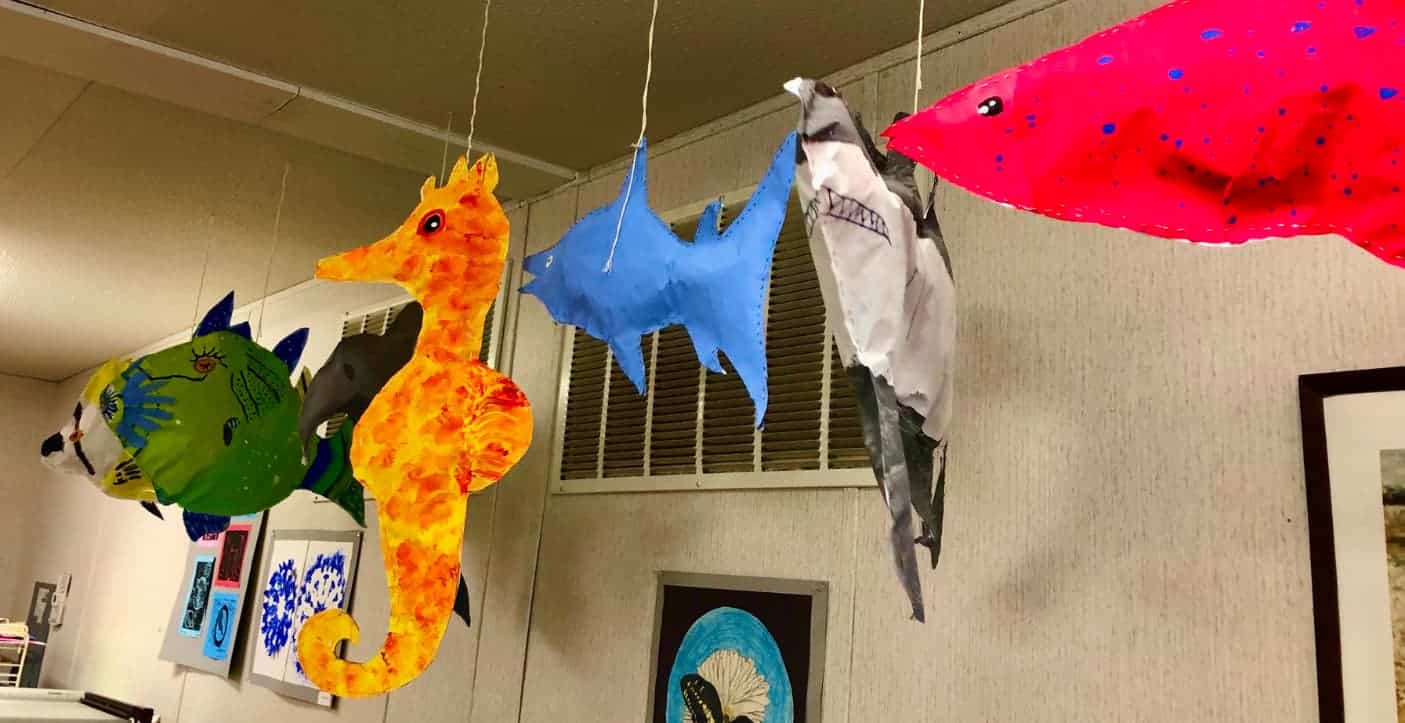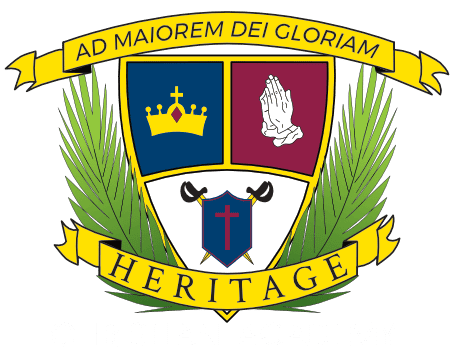School of Grammar (PK-5)
Confidence is developed by building a strong foundation in language arts and math.
Pre-K Program
Our Kindergarten Prep program offers your child the opportunity to learn and grow in a safe, loving, Christ-centered environment. Our classical approach to education concentrates on the 3 essential elements of phonics, handwriting, and math with the integration of Biblical teachings. Students are given the opportunity to build skills through hands-on learning activities and real-life experiences. Daily activities consist of stories, art and music experiences, building relationships, and exploring God’s world. Our program is designed to develop students academically, socially, and emotionally to ensure they make a smooth transition into kindergarten.
Kindergarten-Class 5
The grammar phase of the classical model is thriving at Heritage Christian Academy. In grades K-5, we are equipping students with the tools for decoding and encoding through a strong foundation in phonics and reading as well as teaching the basic skills of handwriting and spelling. During the transition from learning to read to reading to learn, lower school students are exposed to great stories in literature as teachers read aloud and engage students in the classics. Our mathematics instruction is based on the idea of incremental development, which is the belief that students should learn math concepts in small, manageable steps, with each lesson building on the previous one. With this spiral approach to learning, students should master a concept before moving on to the next one. Biblical integration is an important part of instruction. We have amazing teachers who love God’s word and seek ways to integrate it in all subject areas.


Pre-K Curriculum
| Subject | 4-K Kindergarten Prep |
|---|---|
| Program Goals | · To provide a safe Christ-centered environment where students feel safe and encouraged to learn and grow. · To provide opportunities to translate experience into understanding. · To address all aspects of children’s development. · To teach children concepts and skills through active manipulation of objects. · To design activities so that concepts and skills are appropriately presented by utilizing a variety of techniques. · To enable children to experience both challenge and success. · To provide opportunities for social-emotional growth and maturity. · To use language which enhances children’s critical thinking. |
| Bible | School-wide Reading |
| Reading/Writing | Students develop abilities to express themselves clearly and communicate ideas to others. Students begin demonstrating an understanding of basic print conventions. Students learn to engage in appropriate reading behaviors independently. Students begin to recognize and name letters of the alphabet. Students begin to associate sounds with letters. Students begin to show that written words are made up of particular letters. Students begin to develop handwriting skills and correct letter formation. |
| Early Mathematics | Students begin to develop processes and strategies for solving mathematical problems. Students begin to develop skills of comparing and classifying objects. Students begin to develop the ability to recognize shapes and patterns in everyday life. Students begin to develop skills of sorting and organizing information. Students explore and discover simple ways to measure. Students begin to develop an understanding of numbers and operations using concrete objects. |
| Nature Studies | Gardening, SC Furbearers, Birds |
Kindergarten- Class 5 Curriculum
| Subject | Kindergarten | Class 1 | Class 2 | Class 3 | Class 4 | Class 5 |
|---|---|---|---|---|---|---|
| Bible | school-wide Bible reading, prayer, virtues study | school-wide Bible reading, prayer, virtues study | school-wide Bible reading, prayer, virtues study | school-wide Bible reading, prayer, virtues study | school-wide Bible reading, prayer, virtues study | school-wide Bible reading, prayer, virtues study |
| Language Arts/Writing | Writing and Spelling: manuscript handwriting, dictation, copying text Grammar: basic sentence structure, capitalization and punctuation, plurals and possessives | Writing and Spelling: manuscript handwriting, , dictation, encode level-appropriate spelling words, copy texts, write in complete sentences Grammar: verbs and their tenses, adjectives and articles, common and proper nouns, possession and abbreviations, four types of sentences, correct punctuation and capitalization | Writing and Spelling: manuscript handwriting, cursive writing, mastery of phonograms through encoding of spelling words, master formulating and writing complete sentences, introduction to a friendly letter, poetry composition, paragraph writing, and descriptive paragraphs Grammar: mastery of introduction to the eight parts of speech by recitation, give examples for the eight parts of speech | Reading: Demonstrate continued improvement in reading speed, fluency, and expression, reading comprehension on grade-level text, aural comprehension on above grade level text, analyze illustrations, compare and contrast ideas, recognize dialogue, common idioms, story elements, sequence events, understand complete and complex sentences, determine advanced English vocabulary, rhyming structure, exposure to characterization Spelling and Writing: cursive writing, mastery of phonograms introduced in spelling words, correctly use prefixes and suffixes, create and compose from an outline, form a good topic sentence, figures of speech, paraphrase and narrate a piece of writing, summarize a text, create multi-paragraph compositions Grammar: memorize basic grammar rules, plurals, possessives, and compound words, synonyms, antonyms, and homonyms, master basic rules of writing, recognize sentence parts, understand pronouns | Reading: Demonstrate continued improvement in reading speed, fluency, and expression, define vocabulary using context clues, level-appropriate comprehension of material read, compare and contrast, memorize and recitation, allegory, idioms, characterization, aural understanding of above individual reading level, analyze illustrations, gain attention to detail, story elements, literary devices Spelling and Writing: cursive writing, mastery of level-appropriate word lists, master vowel pairs and digraphs, correctly use prefixes and suffixes, correctly use possessives and contractions, Institute for Excellence in Writing Grammar: memorize basic grammar rules pertaining to sentences, verbs, master types of questions, encode dictated sentences | Reading: Read orally with level-appropriate speed, fluency, and expression, display level-appropriate comprehension, determine meaning of unknown vocabulary using context clues, memorization and recitation, literary devices, story elements, aurally understand texts above individual reading level, answer abstract questions, inference, critical reading analysis, growth in narration skills, logic-level questions Spelling and Writing: cursive writing, mastery of level-appropriate word lists, prefixes and suffixes, homonyms and abbreviations, master digraphs, syllabication, Institute for Excellence in Writing Grammar: memorize basic grammar rules, plurals, possessives, and compound words, synonyms, antonyms, and homonyms, master basic rules of writing, recognize sentence parts, understand pronouns |
| Literature | Phonics: letter recognition, letter sounds, 35 essential English phonograms, rhyme Reading: left to right progression, decoding CVC words, sight words, number words, color words, reading speed, fluency, and expression, answering simple questions about a text, vocabulary development, story predictions, orally retelling narrative stories, recognizing main characters, setting, and basic plot, recall facts from nonfiction stories | Phonics: letter sounds, short vowels, long vowels with silent e, long vowel teams, consonant blends, consonant digraphs, r-controlled vowels, phonograms, rhyming, diphthongs, homonyms, contractions, compound words Reading: reading speed, fluency, and expression, answering simple questions about a text independently read, following a storyline, vocabulary, making predictions, comparing and contrasting aspects of a story, story retelling, recalling facts from a nonfiction story, decoding words within real literature, Table of Contents, recognize story elements, sequence events from a story | Phonics: mastery of phonics rules, prefixes, suffixes, and homonyms, syllable and multisyllabic words Reading: understand complex poems in teacher-led discussions, compare and contrast ideas, sequence events within a reading, distinguish between fact and fiction, gain exposure to a variety of literary genres, folk tales, use context clues to attain meaning of unfamiliar vocabulary, continue oral reading to improve fluency, determine meaning of advanced English vocabulary | Memoria Press grade-level texts and supplemental classic literature | Grade-level classic literature | Grade-level classic literature |
| Math | Sorting by color, learning patterns, counting objects, counting in order, skip counting, measuring, time, graphs, story problems | Skip counting, addition and subtraction fact mastery, measurements, adding quarters, drawing polygons, drawing information from graphs, working with larger numbers, geometric shapes, Venn Diagrams, graphs, basic calculations, simple fractions, multi-step problems,spiral review of previously learned concepts | Math fact fluency and computation, multiplication, skip counting, ordinal positions, adding and subtracting multi-digit numbers, dividing by single-digit divisors, adding positive and negative numbers, fractions, measurements, basic geometry, spiral review of previously learned concepts | Math fact fluency and computation, place value, multiplication, division with two-digit quotients, temperature, rounding, fractions, money, decimals, geometric solids, mental math, exploring new concepts, spiral review of previously learned concepts | Math fact fluency and computation, collecting and organizing data, understanding fractions and mixed numbers, adding and subtracting fractions, ratio, percent, and probability, understanding and applying concepts of area and volume, geometry, spiral review of previously learned concepts | Math fact fluency and computation, number concepts, presenting and interpreting data and statistics, number theory and fraction concepts, adding and subtracting fractions, customary standard and metric measurements, integers, algebra concepts, geometry, ratios and proportions, spiral review of previously learned concepts |
| Science | Science Skills: Scientific inquiry, reasoning and problem solving Nature Studies- living & non-living things, water cycle, weather patterns | Science Skills: Scientific inquiry, reasoning and problem solving | Science Skills: Scientific inquiry, reasoning and problem solving Life Science- Animals and environment | Science Skills-Scientific inquiry, reasoning and problem solving Life Science- insects Earth Science- solar system and atmosphere | Pond Communities, Food Plants, Birds and their Habitats, Sound, Earth’s Surface and Resources, Ocean, Weather | Science Skills-Scientific inquiry, reasoning and problem solving Life Science- Anatomy and Physiology Physical Science- matter and mixtures |
| History | Community and Patriotism | Historical people/events, story of the World: Ancient Times, Geography | Early America, Story of the World: The Middle Ages, Geography | South Carolina History Story of the World: Modern Times Geography | History of the USA Story of the World: The Modern Age Geography/Maps | Old World History Story of the World: The Modern Age cont. Geography/Maps |
| Foreign Language | Introduction to Latin | Latin | Latin | Latin | Latin | |
| Related Arts | Music, Art, P.E. | Music, Art, P.E. | Music, Art, P.E. | Music, Art, P.E. | Music, Art, P.E. | Music, Art, P.E. |
Elevating that which is true, good, and excellent.

Phone
803.951.3901
Address:
649 Barr Road
Lexington, SC 29072
